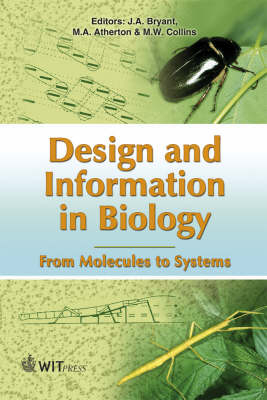
Design and Information in Biology
WIT Press (Verlag)
978-1-85312-853-0 (ISBN)
This volume is the second of two providing the 'holistic introduction' to the "Design and Nature" series that focuses initially on DNA as a starting point for the consideration of the evolution of information and complexity in the natural world. The significance of the dual functions of DNA and the complexity of biomolecules, emphatically revealed by results from the Human Genome Project, are considered both in the context of the way living things work and in relation to the origin of life. Volume 2 complements and extends the scope of Volume 1, with the biological viewpoint being stressed. Following an introductory chapter on design as understood in biology, the various aspects of the biological information revolution are addressed. Areas discussed include molecular structure, the genome, development, and neural networks. Highlighted with individual contributions from eminent specialists, this multi-authored volume combines authority, inspiration and state-of-the-art knowledge. Both informative and inspiring, it is designed to appeal to scientists and interested people alike.
Chapter 1: Introduction: Part I - Design and information in biological systems Design, function and elegance; Evolution and design; Evolution and information; Using the information; Information and the origin of life; Wider aspects of information transfer Chapter 2: Introduction: Part II - Genomes, genes and proteins Introduction; Genome evolution; Organisation of DNA for replication; More on gene structure and function; Gene sequence and cellular function; How many genes are needed?; Variations on a theme; Concluding remarks Chapter 3: Green grass, red blood, blueprint: reflections on life, self-replication, and evolution Of crystals and colloids; Queen Christina's challenge; Different views of life; The beginnings of life on Earth; Models of biogenesis: glimpses of the truth or just-so stories?; Information aspects of life, self-replication and evolution; Virtual worlds; Von Neumann's self-replicating automata; In von Neumann's tracks artificial life; Real-world self-replication; Self-replicating probes for space exploration; Self-replication and nanotechnology; A comparison of natural and artificial self-replication; Trivial vs. non-trivial self-replication; Epistemic cut and semantic closure; Epilogue Chapter 4: The Human Genome Project Introduction; The Human Genome Project; The human genome sequence draft; Functional genomics: assigning function to the genome; Applications of the human genome sequence in medical sciences; Concluding remarks Chapter 5: The laws of thermodynamics: entropy, free energy, information and complexity Introduction; Application of classical thermodynamics to physics; Application of laws of thermodynamics in engineering; Application of thermodynamics to biology - glycolysis and the tricarboxylic acid (Krebs) cycle; Equivalence of thermal and statistical entropy; Role of entropy in contemporary studies; Pros and cons of Shannon entropy; Information and complexity; Evolution - a universal paradigm; Evolution of the biosphere; Thermodynamics, life's emergence and Darwinian evolution; Conclusion Chapter 6: The laws of thermodynamics and Homo sapiens the engineer Introduction; Biology and thermodynamics: a bad start to the relationship; The heat engine and the work engine; The survival engine: e.g. the lizard; Work engines and the dome of the Florence Cathedral; Brunelleschi, the complexity engine; Some consequences for Homo sapiens; Is there a fourth law of thermodynamics?; How mathematical is biology? How chaotic is evolution?; Conclusion Chapter 7: Information theory and sensory perception Introduction; Theories of perception; Information and redundancy; Information and noise in continuous signals; Discussion; Conclusion Chapter 8: Flight Introduction; The origins of flight; Flight roles and techniques; Designs for flight The energetics of flight: power, speed, size and behavioural ecology; Conclusions Chapter 9: Insect observations and hexapod design Introduction; Justification for biologically inspired engineering; Anatomy and leg structure of insects; Insect behaviours; Insect walking; The swing/stance phases; Rough terrain strategies; Compliance; Dynamic considerations; Biological principles for hexapod design Chapter 10: The palm - a model for success? Introduction; Evolutionary theory and complexity; Botanical aspects of palms; Engineering aspects of palms; Conclusions; Glossary Chapter 11: The human world seen as living systems Introduction; The RSA; The living systems approach; Companies; Changing society in the modern world; The human factor; Democracy and justice; Globalisation; Local communities; Conclusion Chapter 12: Searching for improvement Introduction; Fitness landscapes and interactions; Some methods for design improvement; Summary Chapter 13: Living systems, 'total design' and the evolution of the automobile: the significance and application of holistic design methods in automotive design, manufacture and operation Introduction; Living systems, biomimesis and the 'closed loop' economy; Total design, process and methods; Sustainability and Life Cycle Assessment; Three product case histories; The need for change in automotive design, manufacture and operation; Current trends in automotive design and manufacture; Potential changes in the automotive industry; LCA and automotive manufacture; Conclusion Chapter 14: Emergent behaviours in autonomous robots Introduction; Complexity from simplicity - emergent behaviour from simple rules; Modern reactive robots; More complex behaviours; Hardware implementation; Emergent behaviour through evolution; Conclusion
| Erscheint lt. Verlag | 20.10.2006 |
|---|---|
| Reihe/Serie | Design & Nature S. ; v. 2 |
| Zusatzinfo | Ill. |
| Verlagsort | Southampton |
| Sprache | englisch |
| Maße | 165 x 242 mm |
| Themenwelt | Mathematik / Informatik ► Mathematik |
| Naturwissenschaften ► Biologie ► Evolution | |
| ISBN-10 | 1-85312-853-8 / 1853128538 |
| ISBN-13 | 978-1-85312-853-0 / 9781853128530 |
| Zustand | Neuware |
| Haben Sie eine Frage zum Produkt? |
aus dem Bereich


